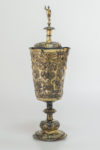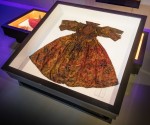 A silver gilt cup found in the wreck of 17th century merchant ship in the Wadden Sea near the island of Texel, northern Holland, has been restored and put on display at the Kaap Skil Museum on Texel.
A silver gilt cup found in the wreck of 17th century merchant ship in the Wadden Sea near the island of Texel, northern Holland, has been restored and put on display at the Kaap Skil Museum on Texel.
It was one of more than a thousand objects recovered from the wreck site in 2014 after shifting sediment exposed them to the elements. Centuries under layers of silt and sand in the cold waters of the Wadden Sea had preserved organic materials in astounding condition. High-end textiles were found in beautiful condition, including silk stockings, a red velvet pouch embroidered with silver thread, and a silk gown so exquisite that one professor described it as “the Night Watch of the costume world.”
 Known as the boxwood wreck, after its cargo of boxwood timbers, or Texel wreck, it was carrying artifacts of such exceptional quality that there was immediate speculation that it might have been transporting members of aristocracy, perhaps even royalty, or at least their stuff. A leather book cover stamped in gold with the coat of arms of King Charles I suggested a Stuart connection and in the initial excitement of the find, the silk gown was identified as having belonged to Jean Kerr, Countess of Roxburghe, lady-in-waiting to Queen Henrietta Maria. That hypothesis was disproved when researchers discovered the dress was made in Northwestern Europe, not England.
Known as the boxwood wreck, after its cargo of boxwood timbers, or Texel wreck, it was carrying artifacts of such exceptional quality that there was immediate speculation that it might have been transporting members of aristocracy, perhaps even royalty, or at least their stuff. A leather book cover stamped in gold with the coat of arms of King Charles I suggested a Stuart connection and in the initial excitement of the find, the silk gown was identified as having belonged to Jean Kerr, Countess of Roxburghe, lady-in-waiting to Queen Henrietta Maria. That hypothesis was disproved when researchers discovered the dress was made in Northwestern Europe, not England.
The most recent findings of the ongoing study into the wreck, announced at the Rijksmuseum last Thursday when the show cup was unveiled, point to the ship having been a Dutch trade vessel traveling from the Levant and Mediterranean through the Straits of Gibraltar. Its cargo attests to its voyages — boxwood trunks, French and Italian pottery, caftans from the Ottoman Empire, a Persian rug,
 The silver gilt cup was also made in continental Europe, likely southern Germany. The cities of Nuremberg and Augsburg were known for their silversmiths who produced show cups like this. Unfortunately the seal that would precisely pinpoint the shop where it was made is missing, but the style of the cup dates it to the late 16th century, so at least 50 years before the ship’s last voyage, estimated to have taken place about 1650.
The silver gilt cup was also made in continental Europe, likely southern Germany. The cities of Nuremberg and Augsburg were known for their silversmiths who produced show cups like this. Unfortunately the seal that would precisely pinpoint the shop where it was made is missing, but the style of the cup dates it to the late 16th century, so at least 50 years before the ship’s last voyage, estimated to have taken place about 1650.
 When it was recovered from the water, the metal cup was in worse shape than the fine silk stockings. It was broken into three pieces and and severely dented, coated in heavy black corrosion. Most of the dents were repairable, thankfully, and the thick crust of corrosion was removed. Restorers worked on it for four years to reveal the intricate details of its decoration. It chased and molded with floral motifs, vases and masks. Standing on the lid is a figurine of Mars. He would have originally held a shield, now lost.
When it was recovered from the water, the metal cup was in worse shape than the fine silk stockings. It was broken into three pieces and and severely dented, coated in heavy black corrosion. Most of the dents were repairable, thankfully, and the thick crust of corrosion was removed. Restorers worked on it for four years to reveal the intricate details of its decoration. It chased and molded with floral motifs, vases and masks. Standing on the lid is a figurine of Mars. He would have originally held a shield, now lost.
 The sometime showpiece is now a showpiece once again, on display from March 9th to September 9th at the museum’s exhibition of select objects from the boxwood wreck. The 450-page report on the wreck, Wereldvondsten uit een Hollands schip (World finds from a Dutch ship, according to the always questionable Google Translate) is available for sale at the museum. I couldn’t find it online, much to my disappointment, because I would nerd out all over that.
The sometime showpiece is now a showpiece once again, on display from March 9th to September 9th at the museum’s exhibition of select objects from the boxwood wreck. The 450-page report on the wreck, Wereldvondsten uit een Hollands schip (World finds from a Dutch ship, according to the always questionable Google Translate) is available for sale at the museum. I couldn’t find it online, much to my disappointment, because I would nerd out all over that.